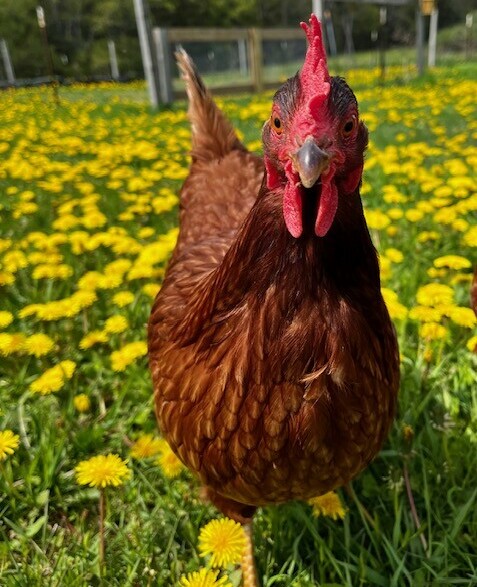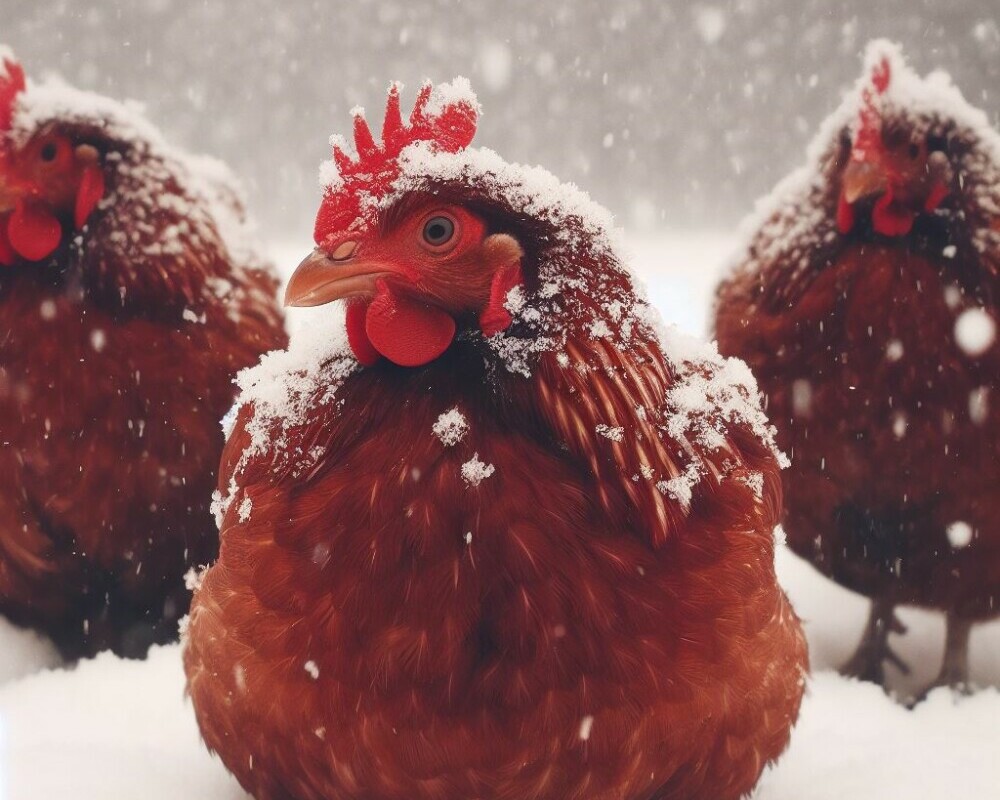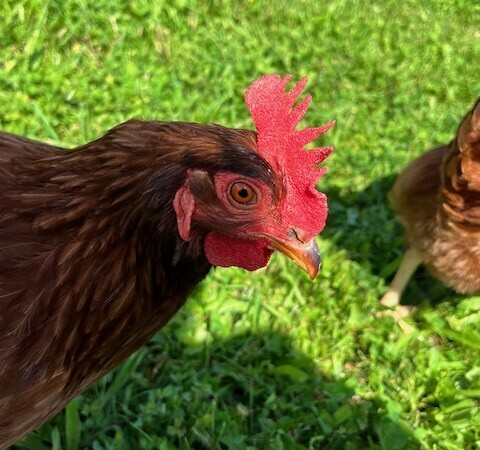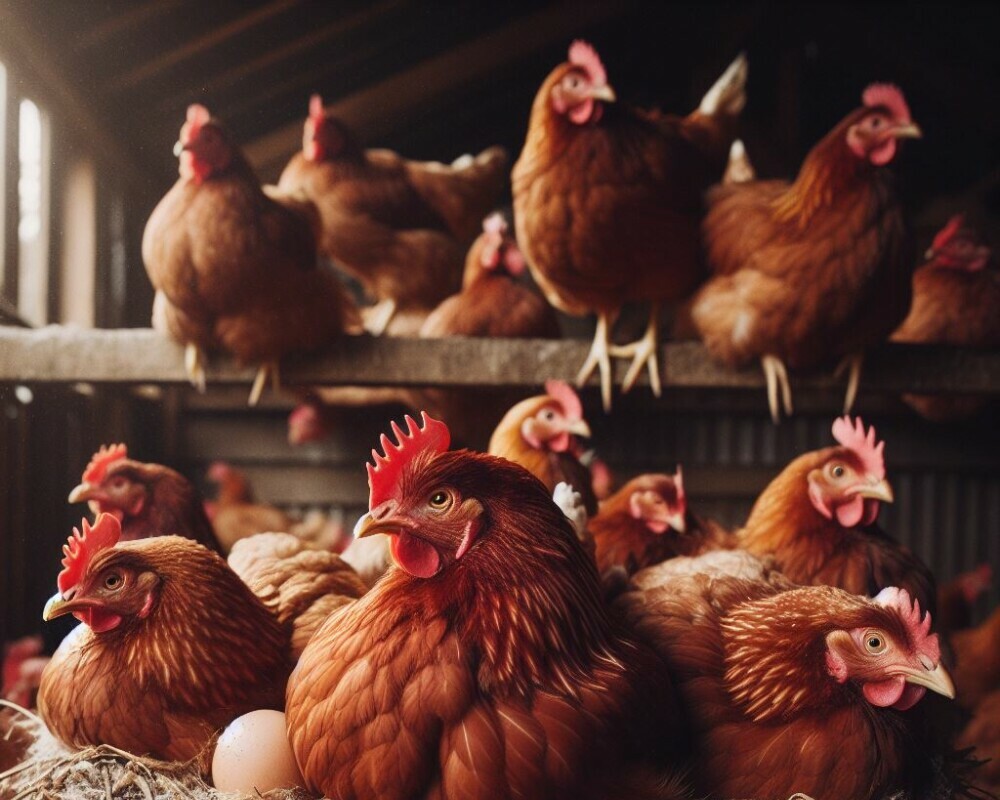
Are you talking to me? Rhode Island Red chickens have a reputation for being tough, sometimes mean, aloof, and self-sufficient, among other things. So, given that description, the answer is Rhode Island Reds need a lot of space.
Now, I’m not saying that they need any more space in the coop or on the range. It’s just more like they don’t appreciate their personal space being invaded.
I’m like that, too, but I’m not out to hurt anybody, and I’m sure the Rhode Island Red is not either.
I, personally, have not had a Rhody that was mean to me or particularly mean to other chickens, although the internet abounds with such stories.
This isn’t just an article about space. I mean, anybody who knows anything about chickens knows that they need about 4-8 square feet of space in the coop and more than that outside, 8-plus feet.
This article is all about our friend, the Rhode Island Red.
Rhode Island Red Chicken Origins
As you have probably guessed, the Rhode Island Red Chicken was developed in the state of Rhode Island.
Emerging from the farmlands of Rhode Island in the mid-19th century, the Rhode Island Red Chicken proudly stands as a testament to Yankee ingenuity and perseverance.
Its robust lineage traces back to a blend of Asian breeds, including the Cochin, Java, Malay, and Shanghai, infused with the fiery spirit of the Italian Brown Leghorn.
This union of East and West gave rise to a chicken of remarkable character, a true embodiment of New England grit. Wearing rich, fiery red plumage, the Rhode Island Red exudes an aura of confidence and self-reliance.

Thanks to my friend Dayle L. for this article’s excellent pictures.
Though often misunderstood, its temperament reflects an independent spirit, a determination to thrive in even the most challenging environments.
While some may perceive their demeanor as aloof or even mean-spirited, those who have taken the time to understand these remarkable birds recognize their inherent strength and resilience.
The Rhode Island Red is not a chicken to be coddled or pampered; it demands respect and admiration for its unyielding spirit.
In a world increasingly dominated by docile, factory-farmed breeds, the Rhode Island Red stands as a beacon of individuality, a reminder of the indomitable spirit that once defined American agriculture.
The Rhode Island Red – A Dual Purpose Breed
Along with the Favorelle and the Plymouth Rock, the Rhode Island Red is known as a dual-purpose breed. Of course, there are many other dual-purpose breeds among the list of chicken breeds. I mention these as examples only and not as an exhaustive list.
A dual-purpose chicken is one that doesn’t lay as well as a layer and isn’t as good for eating as a meat bird, but it’s a better layer than a meat bird, and it’s a better meat bird than a layer. Undertand?
I’m saying that with a dual-purpose chicken, you’ll get plenty of eggs, and you can serve a chicken dinner to company while feeling confident that the chicken will be tasty and tender.
How Many Eggs Can I Expect From My Rhode Island Red?
Rhode Island Red chickens are prolific layers, known for producing around 5-6 eggs per week or 250-300 eggs per year. This impressive laying ability makes them popular for backyard chicken owners and small-scale egg producers. Their eggs are typically medium to large in size and have a light brown shell.
Red Sex-Link Chickens, also known as Red Stars, are prolific layers and are typically the offspring of a Rhode Island Red rooster and a White Plymouth Rock hen with the silver factor. I mention this as a testimony to the Rhode Island Red’s laying ability.
Here’s a breakdown of their egg-laying habits:
- Age: Rhode Island Red hens typically start laying eggs around 4-5 months of age.
- Seasonality: Egg production is highest during the spring and summer months and may decline during the fall and winter.
- Molting: Hens will molt once or twice a year, and egg production may decrease or stop altogether during these periods.
- Diet and Health: A healthy diet and proper care can help ensure that Rhode Island Red hens maintain their high egg-laying productivity.
Rhode Island Red chickens are excellent egg layers, providing a consistent supply of delicious, nutritious eggs for your family or small-scale business.
Are Rhode Island Reds Really Good to Eat?
Rhode Island Reds are good to eat. They have a good flavor and texture, and their meat is relatively lean. They are also a good size for roasting or frying.
Here are some of the reasons why Rhode Island Reds are good to raise for eggs and for eating:
- They are a hardy breed that can tolerate a wide range of climates and conditions.
- They are relatively disease-resistant.
- They are good foragers who can find their own food, saving you money on feed.
- They are prolific layers so that you will have a steady supply of eggs.
- They have a good flavor and texture.
- Their meat is relatively lean.
- They are a good size for roasting or frying.
The Rhode Island Red is a great option if you are looking for a good chicken for eggs and meat. They are a hardy, versatile breed that will provide you with delicious food for years to come.
How Well Do Rhode Island Reds Handle Cold Weather?

Rhode Island Red chickens are known for their cold hardiness, making them popular among people like me in the northeastern United States. It gets pretty darn cold up here from November through March, so cold-hardy chickens are a must-have.
They have several adaptations that help them withstand harsh winters:
- Dense Plumage: Rhode Island Reds have a thick layer of feathers that provides insulation and protection from the cold. This dense plumage helps trap body heat and keeps them warm even in frigid temperatures.
- Down Feathering: Rhode Island Reds have a layer of down feathers underneath their regular feathers. These down feathers are soft and fluffy, providing additional insulation and warmth.
- Small Combs and Wattles: Combs and wattles are fleshy appendages on a chicken’s head that can be susceptible to frostbite in cold weather. Rhode Island Reds have relatively small combs and wattles compared to other breeds, reducing the risk of frostbite.
- Metabolism: Chickens can increase their metabolism to generate more heat in cold weather. Rhode Island Reds are particularly good at this, allowing them to maintain their body temperature and stay warm.
- Body Fat: Chickens store fat in their bodies, which provides energy and insulation. Rhode Island Reds have a good balance of body fat, providing them with an extra layer of protection against the cold.
However, it’s important to provide additional care for Rhode Island Reds in extremely cold weather:
- Draft-Free Coop: Ensure their coop is well-ventilated but free of drafts, which can steal body heat.
- Deep Litter: Provide a deep litter of straw or shavings in the coop to trap heat and keep the floor dry.
- Access to Fresh Water: Ensure they have access to fresh, non-frozen water throughout the day.
- Protection from Wind and Snow: Provide windbreaks and protection from snow around their coop and run.
With proper care and attention, Rhode Island Red chickens can thrive in cold climates and continue laying eggs throughout winter.
Rhode Island Reds – Masters of the Open Range

I’ll wrap this up with a discussion of Rhode Island Red’s free-range abilities. Among their many attributes, foraging is one of the strongest traits of the breed.
Rhode Island Reds are renowned for their exceptional foraging prowess. Their ability to find and consume a variety of insects, grubs, worms, seeds, and greens not only supplements their diet but also contributes to their overall health and well-being.
Natural-Born Foragers
Rhode Island Reds possess an innate instinct to forage, driven by their curiosity and desire to explore their surroundings. Their strong legs and sharp beaks allow them to scratch the ground effectively, unearthing hidden treasures like grubs and earthworms.
Their keen eyesight guides them towards anything that moves, wiggles, riggles, or jiggles, ensuring they don’t miss a single opportunity for a nutritious snack.
Dietary Benefits
Foraging plays a crucial role in the diet of Rhode Island Reds, providing them with essential nutrients that may not be adequately supplied in their commercial feed.
Insects, grubs, and worms are rich sources of protein, while seeds and greens offer a variety of vitamins, minerals, and antioxidants.
These nutrient-rich supplements promote overall health, support egg production, and boost their immune system.
Behavioral Enrichment
Foraging is not merely a means of sustenance for Rhode Island Reds; it’s also a source of behavioral enrichment.
The act of searching, scratching, and pecking provides them with mental stimulation and physical activity, keeping them engaged and active throughout the day.
This mental and physical engagement helps prevent boredom, reduces stress, and contributes to their overall well-being.
Pest Control Advantages
Rhode Island Reds’ foraging prowess extends beyond their nutritional needs, providing an added benefit of natural pest control.
Their insatiable appetite for insects and grubs can help reduce populations of pests that may damage your health, garden, or crops. They eat ticks! That alone is worth a lot.
Their presence can deter other pests, such as slugs and snails, from invading your garden.
Overall, Rhode Island Reds’ exceptional foraging ability is a significant advantage for both the chickens and the environment. It supplements their diet, enhances their health and well-being, provides behavioral enrichment, and contributes to natural pest control. Their ability to thrive in free-range settings makes them an excellent choice for backyard chicken enthusiasts seeking a productive and environmentally friendly breed.
Closing The Coop and Letting Them Roost

Rhode Island Red chickens are popular for backyards and small-scale egg producers.
They are known for their hardiness, adaptability, and foraging ability. Rhode Island Reds are good to eat, producing a good flavor and texture. They are also relatively lean.
With proper care, Rhode Island Reds can thrive in a variety of climates and continue to lay eggs throughout the winter.
Overall, Rhode Island Reds are a versatile and productive breed well-suited for various environments.
So, Give them some space, and they will reward you with many gifts while gracing your backyard with a splash of fiery charm.
Thank you to Dayle L. for providing excellent pictures.
Thank you for reading. If you have any Rhode Island Red stories to share, please leave them in the comments below. People love a good chicken story. Here’s a link if you want to learn more about Chickenmethod and me.
Dave
Chickenmethod.com
